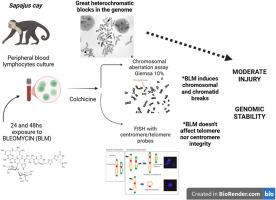Analysis of the in vitro response of the Sapajus cay (Primates: Platyrrhini) genome to exposure to the radiomimetic bleomycin
IF 3.5
3区 生物学
Q3 CELL BIOLOGY
引用次数: 0
Abstract
Bleomycin (BLM) is an antitumor and antibiotic agent widely used as a positive control in genotoxicity assays due to its ability to induce mutagenic effects across multiple organisms. In mammalian cells, BLM causes chromosomal damage, affecting both chromatids and chromosomes, including complex aberrations involving multiple chromosomes. A key question arises regarding the response to BLM-induced genotoxic stress in genomes with pronounced structural differences from the human genome, which may influence genomic stability. The Sapajus genus (Cebidae, Platyrrhini) is notable for its genome, which contains approximately 8–15 % heterochromatin—an unusually high proportion compared to other platyrrhines—and its remarkable conservation of euchromatic regions relative to the human karyotype. Given the critical role of heterochromatin in genome stability, understanding the DNA damage response mechanisms in heterochromatin-enriched genomes like that of Sapajus is essential to assessing their implications for chromosomal integrity and adaptation. In this study, peripheral blood lymphocytes from Sapajus cay were exposed to BLM, resulting in the induction of dicentrics, chromosomal and chromatid breaks. Notably, no complex chromosomal figures involving multiple chromosomes were observed. These findings provide valuable insights into the genomic stability of Sapajus cay in response to genotoxic stress, with potential implications for evolutionary and biomedical research.

白颈猴基因组对模拟辐射博来霉素的体外反应分析
博来霉素(BLM)是一种抗肿瘤和抗生素药物,由于其在多种生物间的诱变作用,在遗传毒性试验中被广泛用作阳性对照。在哺乳动物细胞中,BLM引起染色体损伤,影响染色单体和染色体,包括涉及多染色体的复杂畸变。一个关键的问题是,与人类基因组有明显结构差异的基因组对blm诱导的基因毒性应激的反应可能会影响基因组的稳定性。Sapajus属(Cebidae, Platyrrhini)以其基因组中含有约8 - 15%的异染色质而闻名,这一比例与其他Platyrrhini相比异常高,并且相对于人类核型,Sapajus属具有显着的常染色质区域保守性。鉴于异染色质在基因组稳定性中的关键作用,了解像Sapajus这样富含异染色质的基因组中的DNA损伤反应机制对于评估其对染色体完整性和适应性的影响至关重要。在本研究中,将白枣的外周血淋巴细胞暴露于BLM中,导致双中心分裂、染色体和染色单体断裂。值得注意的是,没有观察到涉及多个染色体的复杂染色体图。这些发现提供了有价值的见解,以了解Sapajus day在基因毒性应激反应中的基因组稳定性,对进化和生物医学研究具有潜在的意义。
本文章由计算机程序翻译,如有差异,请以英文原文为准。
求助全文
约1分钟内获得全文
求助全文
来源期刊

Experimental cell research
医学-细胞生物学
CiteScore
7.20
自引率
0.00%
发文量
295
审稿时长
30 days
期刊介绍:
Our scope includes but is not limited to areas such as: Chromosome biology; Chromatin and epigenetics; DNA repair; Gene regulation; Nuclear import-export; RNA processing; Non-coding RNAs; Organelle biology; The cytoskeleton; Intracellular trafficking; Cell-cell and cell-matrix interactions; Cell motility and migration; Cell proliferation; Cellular differentiation; Signal transduction; Programmed cell death.
 求助内容:
求助内容: 应助结果提醒方式:
应助结果提醒方式:


